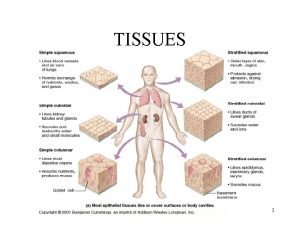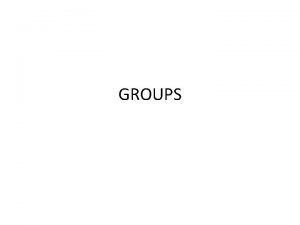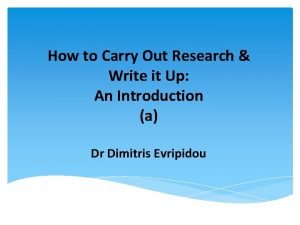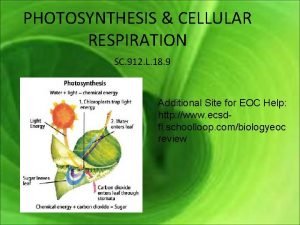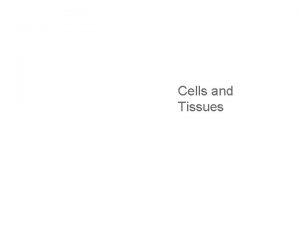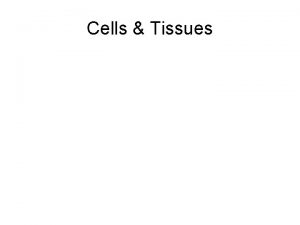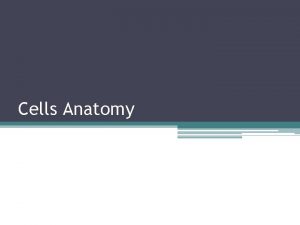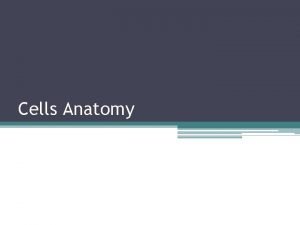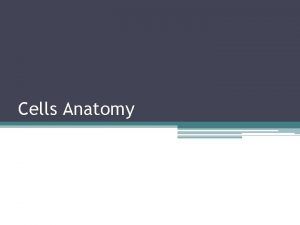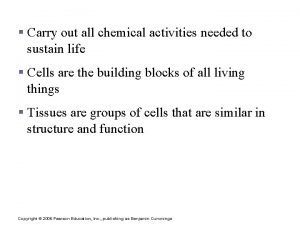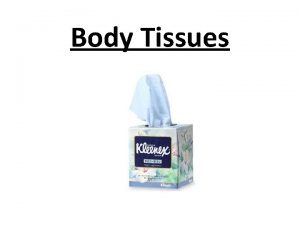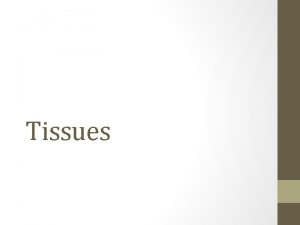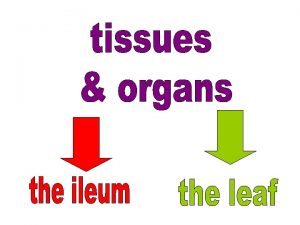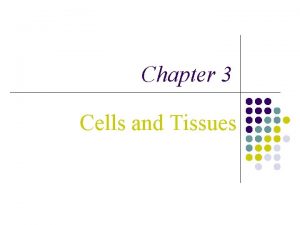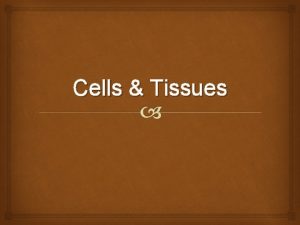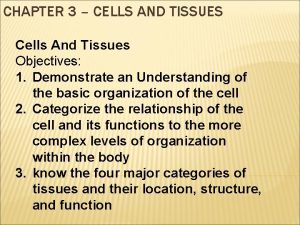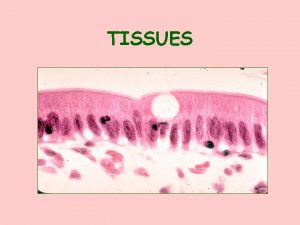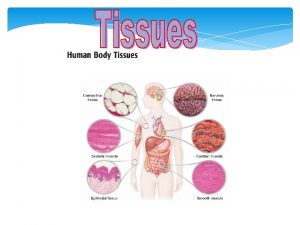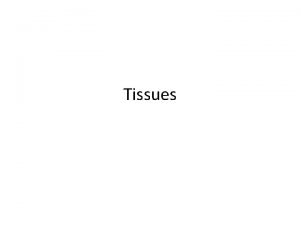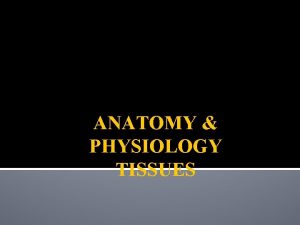TISSUES Tissues group of cells that carry out





































- Slides: 37

TISSUES! Tissues – group of cells that carry out specialized activities Histology = study of tissues Pathologists – Study diseased tissue

Tissues • TISSUE • similar cells working together • ORGAN • similar tissues that form one structure that works together

4 large groups of tissue types: 1. epithelial 2. connective 3. muscular 4. nervous

Four Main Types Epithelial Connective Binds organs together; energy reserves Muscle Body surface, hollow organs, glands Movement and force Nervous Stimulates nerve impulses

Functions: Protection, Filtration, Secretion, Absorption, and Excretion Divisions: 1. Coverings and Linings 2. Glands

EPITHELIAL Covers outer body Lines hollow organs & body cavities Covers glands

Shape & Layers of epithelial

Examples (Draw these!)


Simple Squamous Function: Filtration, diffusion, osmosis, and secretion in serous membranes Location: Kidneys Glomeruli (water, glucose, and wastes), Air Sac of Lungs (Gas Exchange), Heart and Blood Vessels (Nutrients & Medicine)

Simple Cuboidal Function: Secretion and Absorption Location: Location Kidney Tubules (Wastes), Ovary Surface (Ova)

Ciliated Simple Columnar Function: Moves fluids and particles along passageways Location: Found in respiratory tract (mucosal Movement), fallopian tubes (Ova movement), sinuses (Pathogen removal Runny Nose) Cilia

Binds organs together, energy reserves for fat

CONNECTIVE most abundant wide spaces between cells filled with matrix can be liquid, semi-solid, or solid matrix contains elastic fibers & collagen

Connective Tissue

8 1. areolar (loose)- • 2. types of connective tissue: packing material; surrounds organs to prevent them from moving around adipose (loose) https: //www. youtube. com/watch? v=k-_0 ol 8 j. N 0 k https: //www. youtube. com/watch? v=57 g 3 d. Kz. YMu. U • stores FAT; insulation; energy; cushion

Fibroblasts Collagen • Provides strength, elasticity, and support to subcutaneous layer and pappilary regions of skin • Consists of Collagen, Elastic, Reticular fibers Elastin

Nucleus Fat Storage Blood Vessel Insulation Energy Reserves

Types of Connective Tissue 3. fibrous- (dense) can withstand force tendons (attach m to b) & ligaments (attach b to b)

• Dense, Closely packed collagen fibers that provide high tensile strength • Strong attachment for Tendons (Muscle to Bone), Ligaments (Bone to Bone)

Types of Connective Tissue 4. elastic- joins together 33 vertebrae to keep spine aligned

Elastic Tissue

Types of Connective Tissue 5. cartilage- aka “gristle” covers ends of bones; shock absorbers; nose, ears, trachea, spine

Cartilage White Fibrocartilage • Extremely tough • Acts as a shock absorber, ball and socket joints Elastic Cartilage • Abundance of elastin for stretching capability • Nose, Ears, epiglottis, larynx

Types of Connective Tissue 6. bone- “osseous tissue”; hard matrix 7. blood the only liquid tissue; 3 types of cells in liquid plasma

Calcium Haversian Canal Compact vs. Spongy • Provides for support, Movement-Marrow (blood-forming)

• Oxygen Transport • Clotting (platelets) • Immunity (WBC’s) • Nutrient delivery

Types of Connective Tissue 8. reticular- scattered through body phagocytic (ingest bacteria/viruses)

Movement and force application

MUSCULAR purpose: contraction = shortening & thicken to cause movement * work in antagonistic pairs (opposite) Biceps flexes arm Triceps extends arm


Skeletal Muscle Tissue Attached to bones by tendons Functions in body movements, posture, thermogenesis Only Muscle tissue controlled voluntarily

Smooth Muscle Tissue Forms walls of many internal organs ie: Stomach, GI tract, Uterus, Anus Functions in motion of internal organs

• Composes the heart wall • Functions in pumping blood to all parts of the body • Intercalated discs contain Gap Junctions (Communication) & Desmosomes (Anchor)

NERVOUS in brain, spinal cord, & nerves nerve cells = “neurons” respond to stimulus by transmitting electrical impulses

• Consists of Neuron and Neuroglia • Neuron – Conversion from stimulus response to action potential (Sensory, Motor, Interneuron) 1. Dendrites – Reacts to stimuli 2. Axons – Conductor of impulse Axon Nucleus Dendrite

Sad? Need a Tissue?
 Body tissue
Body tissue The 4 tissues
The 4 tissues Body tissues chapter 3 cells and tissues
Body tissues chapter 3 cells and tissues Eisonophil
Eisonophil Anatomy chapter 3 cells and tissues
Anatomy chapter 3 cells and tissues Tissues are groups of similar cells working together to
Tissues are groups of similar cells working together to Tissues are groups of similar cells working together to
Tissues are groups of similar cells working together to Division of anatomy
Division of anatomy Chapter 3 cells and tissues
Chapter 3 cells and tissues Cell membrane phospholipids
Cell membrane phospholipids What is the function of the golgi apparatus
What is the function of the golgi apparatus Tissues are groups of similar cells working together to:
Tissues are groups of similar cells working together to: Metaphors in one direction songs
Metaphors in one direction songs Phân độ lown ngoại tâm thu
Phân độ lown ngoại tâm thu Block nhĩ thất cấp 1
Block nhĩ thất cấp 1 Thể thơ truyền thống
Thể thơ truyền thống Thơ thất ngôn tứ tuyệt đường luật
Thơ thất ngôn tứ tuyệt đường luật Chiến lược kinh doanh quốc tế của walmart
Chiến lược kinh doanh quốc tế của walmart Tìm vết của mặt phẳng
Tìm vết của mặt phẳng Con hãy đưa tay khi thấy người vấp ngã
Con hãy đưa tay khi thấy người vấp ngã Tôn thất thuyết là ai
Tôn thất thuyết là ai Gây tê cơ vuông thắt lưng
Gây tê cơ vuông thắt lưng Sau thất bại ở hồ điển triệt
Sau thất bại ở hồ điển triệt In group out group
In group out group William graham sumner in group out group
William graham sumner in group out group Carry out the research
Carry out the research Extension work activities
Extension work activities Why was john proctor frequently absent from church
Why was john proctor frequently absent from church What function does atp carry out in living things
What function does atp carry out in living things Food tests questions
Food tests questions Cell to tissue to organ to organ system to organism
Cell to tissue to organ to organ system to organism Onodi cells and haller cells
Onodi cells and haller cells Proximal convoluted tubule
Proximal convoluted tubule Parafollicular cells vs follicular cells
Parafollicular cells vs follicular cells Gametic cells vs somatic cells
Gametic cells vs somatic cells Somatic vs germ cells
Somatic vs germ cells Chlorocruorin
Chlorocruorin Eukaryotic vs prokaryotic
Eukaryotic vs prokaryotic






